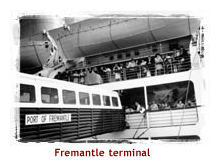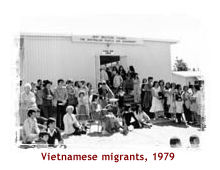|
Migration Large-scale immigration from non-English speaking European countries began after the Second World War. In the 1960s roughly 50% of settlers came from the United Kingdom and Ireland, while approximately 30% came from Greece, Italy, Yugoslavia, Germany and Malta. By the mid-1970s Western Australia's ethnic makeup had changed considerably. The White Australia Policy effectively ended in 1966 when the Liberal Government of Prime Minister Harold Holt allowed the migration of 'distinguished' non-Europeans. The new policy also recognised that large numbers of migrants, especially those whose first language was not English, were experiencing many hardships as they settled into life in Australia, and required more direct assistance. Expenditure on migrant assistance and welfare rose sharply in the early 1970s in response to these needs.  Around
that time immigration from south-east Asia saw the numbers of Vietnamese
and Chinese immigrants to Australia rapidly increase. Until then the number
of settlers from the Asian region was small. By the early 1970s the number
of migrants from Asia began to increase, peaking between 1988-89 (55,700)
and 1990-91 (60,900). By 1997-98, a total of 25,300 migrants, or 33% of
all settler arrivals, were born in Asia. Around
that time immigration from south-east Asia saw the numbers of Vietnamese
and Chinese immigrants to Australia rapidly increase. Until then the number
of settlers from the Asian region was small. By the early 1970s the number
of migrants from Asia began to increase, peaking between 1988-89 (55,700)
and 1990-91 (60,900). By 1997-98, a total of 25,300 migrants, or 33% of
all settler arrivals, were born in Asia. While there have always been many races living in Western Australia it has
not been until the last thirty years that Western Australia has become truly
multi-racial
or multi-cultural.
While there have always been many races living in Western Australia it has
not been until the last thirty years that Western Australia has become truly
multi-racial
or multi-cultural.The increase in long-term visitors from Asia over the last ten years has contributed to the diversity and vitality of Australian culture. Almost 60,000 long-term visitors arrived in Australia from Asia in 1997-98. This represented nearly 60% of all long-term visitors, a twelve-fold increase over 20 years. The main reason for this growth has been the increasing number of students travelling to Australia from Asia for educational purposes. Western Australia has participated in this burgeoning international education industry with a large proportion of international students coming from south-east Asia. |
Please note: The content on this website is made available for archival purposes and may not meet the State Library of Western Australia's current standards for web accessibility, mobile device compatibility, historical accuracy and cultural sensitivity.